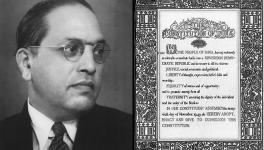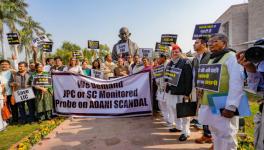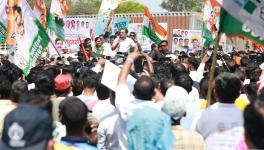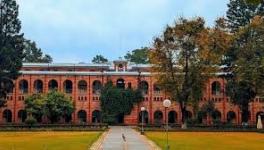Hindu Right should Know: Savarkar said Hindutva isn’t Hinduism
A recent statement by Congress leader Rahul Gandhi has reignited the Hinduism versus Hindutva debate. The right-wing immediately portrayed his rejection of Hindutva as an insult to the Hindu faith. Bharatiya Janata Party (BJP) minister from Haryana Anil Vij declared as “fake” Hindus those who do not adhere to Hindutva. At the same time, Congress supporters ran a hash-tag, “Hindu hain hindutvvaadi nahi—We are Hindu, not Hindutvadi”.
The Hindu/Hindutva debate is old and has roots in the freedom movement. It was Vinayak Damodar Savarkar who coined the term ‘Hindutva’ in a booklet published in 1923. He tried hard to popularise it during the 1930s and forties, to counter the Congress party and establish the Hindu Mahasabha as the sole representative of Hindus. In the communally-polarised atmosphere during and after World War II, his constant advocacy of Hindutva was part of his endeavour to establish a political organisation that could grab power in ‘Hindu India’ vis-à-vis ‘Muslim Pakistan’.
While Savarkar could not divert enough Hindus from the Congress to the Hindu Mahasabha in his lifetime, his Hindutva ideology was subsequently propagated and popularised by the RSS. Ultimately, the RSS established a kind of hegemony in the post-liberalisation period.
It is not without purpose that the present regime is working hard to re-establish Savarkar while its ideological wing produces book after book in his praise. It is high time to revisit the concept of Hindutva as propagated by Savarkar and adopted by the RSS.
What is Hindutva?
The official website of Savarkar claims that the booklet with the term ‘Hindutva’ was written in 1923 during his time in Ratnagiri prison. However, in another section, the same website claims the booklet was written in 1921-’22 when Savarkar was imprisoned in Andaman. Regardless, the booklet first came to light in May 1923, when VV Kelkar, a distant relative of Savarkar, published it under the pseudonym ‘A Maratha’. There is no information about the writer in the publisher’s note.
The second edition published in 1942 credits Savarkar as the writer and clarifies that his name was earlier omitted since he was incarcerated. It is strange how Savarkar successfully smuggled the manuscript outside, but unlike his earlier work, ‘The First War of Independence’, the British administration allowed this one to circulate freely. The booklet was not banned in 1923 or 1942. The timing of the second edition is also noteworthy. In 1942, the Congress adopted the Quit India resolution, and the British administration started vehemently igniting communalism by promoting MA Jinnah and Savarkar.
There is a sloka on the publisher’s page of the second edition published by ‘Veer Savarkar Publication’:
आसिन्धु सिंधु-पर्यन्ता यस्य भारत-भूमिका
पितृभू: पुण्यभूश्चैव स वै हिंदुरिति स्मृतः
[Hindu means one who regards this land Bharatvarsha, from Indus to the Seas as his Father-Land as well as Holy-Land, that is the cradle land of his religion.]
The publisher, SS Savarkar, claims that “this couplet has now come to exercise the authority of a quotation from Holy Scriptures”. This self-realisation may be the reason behind its shift from page 103 of the first edition to the publisher’s page in the second edition. He quotes another verse from Rigveda with this couplet, in which Aryans pray for the destruction of the aborigine Dasas!
At any rate, this sloka defines Hindutva, which it says contains two significant requirements. First, only they come under the purview of Hindutva, whose forefathers have been inhabitants of the country—the notion of “Father-Land”. It is nothing but a precondition of nationality, but by using the term Fatherland instead of the popular notion of Motherland, the nation is given patriarchal leverage. From the Great Revolt of 1857, Bharat Mata Ki Jai or Hail Mother India was the Indian struggle against imperialism. Savarkar replaces ‘Mother’ with ‘Father’.
The more prominent inclusion was ‘Holy-land’ or Punyabhoomi. It was defined as the “land of one’s prophets and seers, of his godman and gurus, the land of piety and pilgrimage”. This definition clearly means to exclude members of other religions such as Christianity and Islam from Hindutva.
Hindutva not religious but political identity:
Savarkar may have the right to define his religion, but further reading of the booklet clarifies that Hindutva is not a definition of religion but citizenship. He claims that India is essentially a Hindu nation, and only those who are Hindu according to his definition shall be eligible for citizenship of the country. Therefore, it is a political identity based on the racial concept of nationalism and used to exclude non-Hindus, which is why he refers to India as “Hindusthan”. The ethnic/racial concept of religion was more vehemently proposed by the second RSS chief MS Golwalkar in his book, ‘We or Our Nationhood Defined’. His definition sought to define the composition of the Hindu Rashtra, with three significant constituents:
-
While Hindus, Jains, and Buddhists were within the framework of Hindutva, Islam, Christianity, and Jews were not.
-
Those outside Hindutva were also excluded from the citizenship of the Hindu Rashtra.
-
The condition for non-Hindus to attain citizenship in Hindu Rashtra was to convert into the Hindu fold by marriage or other means.
Racial nationalism was a concept borrowed from Fascist Germany and Italy, which racially divided citizens and created an outsider within the nation. No wonder, Golwalkar openly praised Hitler and RSS ideologues still idolise Zionist Israel.
Hindutva is Savarkar’s Two-Nation Theory
In his first presidential address to the Hindu Mahasabha in Ahmedabad in 1937, Savarkar recited the sloka mentioned above and declared the task before the Hindu Mahasabha. He said the mission was “maintenance, protection and promotion of the Hindu race, culture and civilisation for the advancement and glory of ‘Hindu Rashtra’”, which is “pre-eminently a national body representing the Hindu Nation as a whole”.
He said the Hindu Mahasabha was not a religious but political body that aimed to establish a Hindu nation. “The Hindus are a Nation by themselves,” he said. It was a clear proposal of the two-nation theory. Savarkar minced no words when he said there are “two antagonistic nations living side by side in India...the Hindus and the Moslems...”
This notion of a Hindu nation was parallel to that of a Muslim nation proposed by the Muslim League a bit later. The aim was again not religious but political. In this first address and every subsequent one, Savarkar appeals to countrymen to “vote only for those who pledge to defend Hindutva”. He also wished to please the British masters during World War II, when the Congress refused to cooperate with the war effort and passed the Quit India resolution, resulting in the imprisonment of almost all its leadership.
Savarkar then presented himself as the leader of Hindus, ran recruitment drives for the British Army and inducted a few supporters into the War Council. In the absence of Congress leadership, the British rulers flirted with Jinnah and Savarkar, who pursued the development of alternative representation in India.
However, after the Congress leadership got released, Savarkar failed to prove his mettle. The Mahasabha fared poorly in the elections. Yet, the division he and Jinnah created aided the imperial design to divide and rule and ultimately resulted in Partition.
Hindutva is not Hinduism:
On the third page of Savarkar’s booklet, a subhead states: “Hindutva is different from Hinduism.” He says Hindutva is “not a word but a history” and must not be mistaken for or “confounded with the other cognate term, Hinduism”. Nor does Hindutva relate to just the religious history of Hindus or Hindu traditions. Explaining the difference between the two, he writes, “...when we attempt to investigate into the essential significance of Hindutva we do not primarily—and certainly not mainly—concern ourselves with any particular theocratic or religious dogma or creed. Had not linguistic usage stood in our way then ‘Hinduness’ would have certainly been a better word than Hinduism as a near parallel to Hindutva. Hindutva embraces all the departments of thought and activity of the whole being of our Hindu race.”
Obviously, he did not coin the term Hindutva to represent any features of Hindu dharma. It can safely be defined as political Hinduism, which places Jainism, Sikhism and Buddhism in the Hindu fold, excluding Islam, Christianity and other so-called non-Indian religions. It is also an attempt to give Hinduism a monolithic political identity while rejecting its philosophical and spiritual content. It borrows the idea of racial superiority from the German and Italian fascists, creating un-Hindu-like distortions to communalise the body politic. Plus, it helped the British counter the nationalist leaders call for communal harmony.
A noteworthy fact regarding Savarkar’s approach towards so-called Indian religions was that he tried hard to rope in BR Ambedkar into his fold. Still, when the latter chose Buddhism over Hinduism, Savarkar took to bitterly abusing him in his articles.
Political Hinduism has always stood against religious Hinduism and secular nationalism. The writings of Savarkar are full of hatred towards not just Muslims but also Gandhi, Nehru, Bose, Patel and other nationalist leaders who were Hindu. This hate is typical of the proponents of the two-nation theory. While Jinnah termed the non-League Muslims such as Maulana Azad as fake Muslims, Savarkar and his followers call those Hindus fake who do not adhere to Hindutva. League goons attacked secular nationalists such as Azad and Shafi Ahmed Kidwai, and a disciple of Savarkar killed Gandhi. The Kapoor Commission clearly indicated Savarkar as the chief conspirator of Gandhi’s murder.
Reincarnation of Savarkar and Unending Debate
Gandhi’s murder resulted in a constant decline of the Hindu Mahasabha and Savarkar. Soon, the RSS replaced the Mahasabha as representative of the Hindu right and launched the Jana Sangh as its political front. Syama Prasad Mookerjee switched sides, and Savarkar led a lonely life after that, delivering the occasional lecture and writing highly reactionary books such as ‘Six Epochs of Indian History’, which advocates rape as a political weapon to establish a Hindu nation.
While Savarkar was not given much importance by the new RSS leadership and its political fronts, they followed and propagated his Hindutva ideology and quest for a Hindu nation. After his clemency petitions surfaced in the public arena, the image of Savarkar got tarnished further. By the 1990s, he was quite a forgotten figure within and outside the political field. However, once it came to power, the BJP launched efforts to reincarnate Savarkar, for example, by renaming the airport in Andaman after him. During its second stint in power with an absolute majority, BJP leaders began openly praising Nathuram Godse and appealed for changes to the Constitution to declare India a Hindu nation. Right-wing activists seized this moment to write voluminous tomes praising Savarkar, normalising his Hindutva hate politics and his cowardly quest for clemency.
The process of communalising history and tarnishing the idea of India developed during the freedom struggle has rekindled the Hindutva versus Hinduism debate. While Hinduism, like the Constitution, conflicts with no faith in India, Hindutva forces are hell-bent on demonising minorities and secular forces. That is why the right-wing rumour factory continuously hatches conspiracies to character-assassinate figures such as Nehru and Gandhi.
Like any other religion, Hinduism has its flaws and beauty. One stream of Hinduism advocates Vasudhaiv Kutumbkam, non-violence and co-existence, which Gandhi practised when he tried fostering harmony between and within religions, by opposing untouchability or other caste-based practices, for example. Other social movements also did this work, and much more is required to demolish caste and gender inequalities within Hindu society. However, Hindutva remains a violent ideological stream that attempts to conceal the flaws within Hindu society, establish upper-caste hegemony, support patriarchy and nurture communal tensions to polarise the electorate and secure political mileage. It is high time to vocally expose the doublespeak of right-wing politics and strongly oppose the treacherous idea of Hindutva to save the Constitution.
The author has written books on Kashmir and Gandhi. His next book on Savarkar is to be published soon. The views are personal.
Get the latest reports & analysis with people's perspective on Protests, movements & deep analytical videos, discussions of the current affairs in your Telegram app. Subscribe to NewsClick's Telegram channel & get Real-Time updates on stories, as they get published on our website.






















